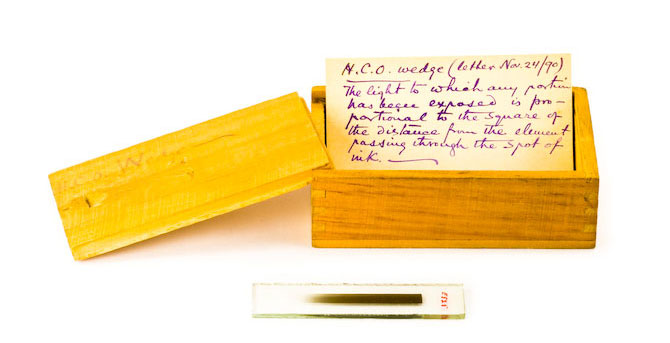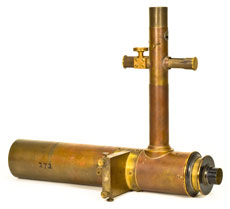
A wedge for visual stellar photometry
 instrument characteristics. Differences in individual visual perception, an inherent problem
when eyes are the detectors, made repeatable measurements even more difficult.
E. C. Pickering, astronomer and director of the Harvard College Observatory, designed a
photometer that he hoped would make measurements more accurate and repeatable. He proposed using the
device in a cooperative program to measure faint stars at several observatories. Lick agreed to participate and was
provided one of the instruments—Photometer No. 3 (left)—in 1900. The photometer contained a
small electric lamp which projected an "artifical star" onto
a piece of glass so that it appeared next to the actual star to be measured. The
wedge pictured above was slid in front of the lamp, gradually dimming it until
the brightness of the artificial star matched that of the real one. The position of
the wedge was then read from a scale, and the brightness of the target star estimated.
Lick Historical Collections, catalog nos. SO000288 (wedge) and SO000272 (photometer)
instrument characteristics. Differences in individual visual perception, an inherent problem
when eyes are the detectors, made repeatable measurements even more difficult.
E. C. Pickering, astronomer and director of the Harvard College Observatory, designed a
photometer that he hoped would make measurements more accurate and repeatable. He proposed using the
device in a cooperative program to measure faint stars at several observatories. Lick agreed to participate and was
provided one of the instruments—Photometer No. 3 (left)—in 1900. The photometer contained a
small electric lamp which projected an "artifical star" onto
a piece of glass so that it appeared next to the actual star to be measured. The
wedge pictured above was slid in front of the lamp, gradually dimming it until
the brightness of the artificial star matched that of the real one. The position of
the wedge was then read from a scale, and the brightness of the target star estimated.
Lick Historical Collections, catalog nos. SO000288 (wedge) and SO000272 (photometer)